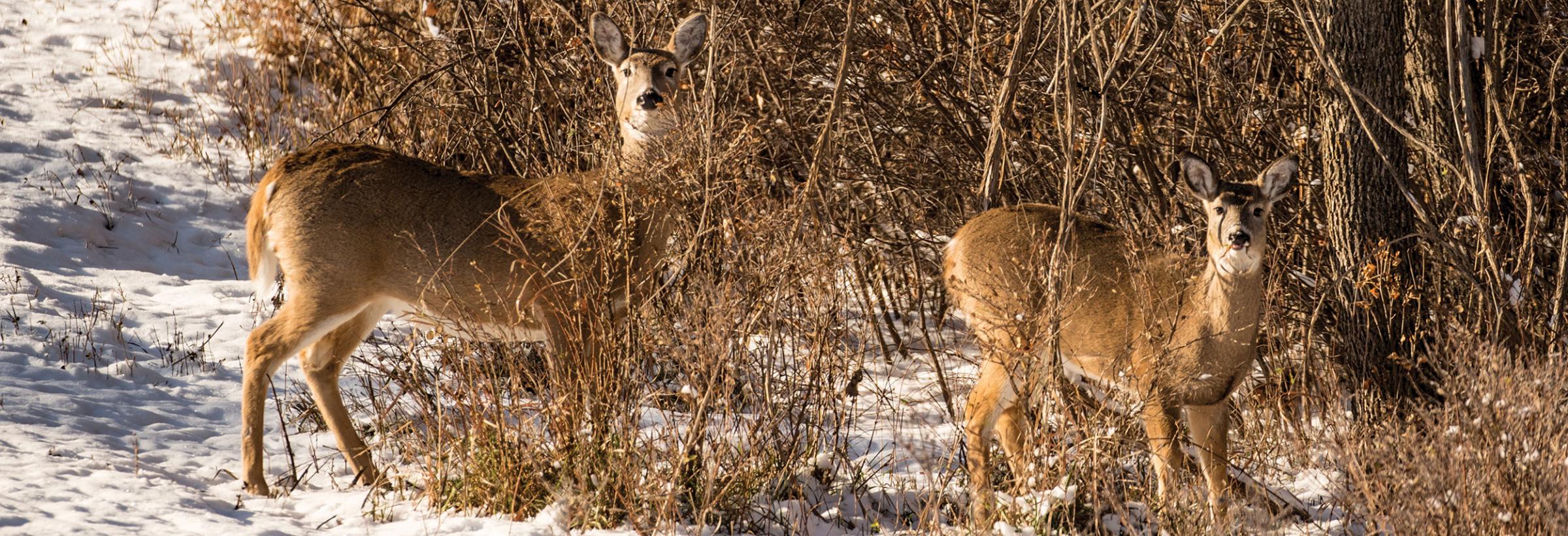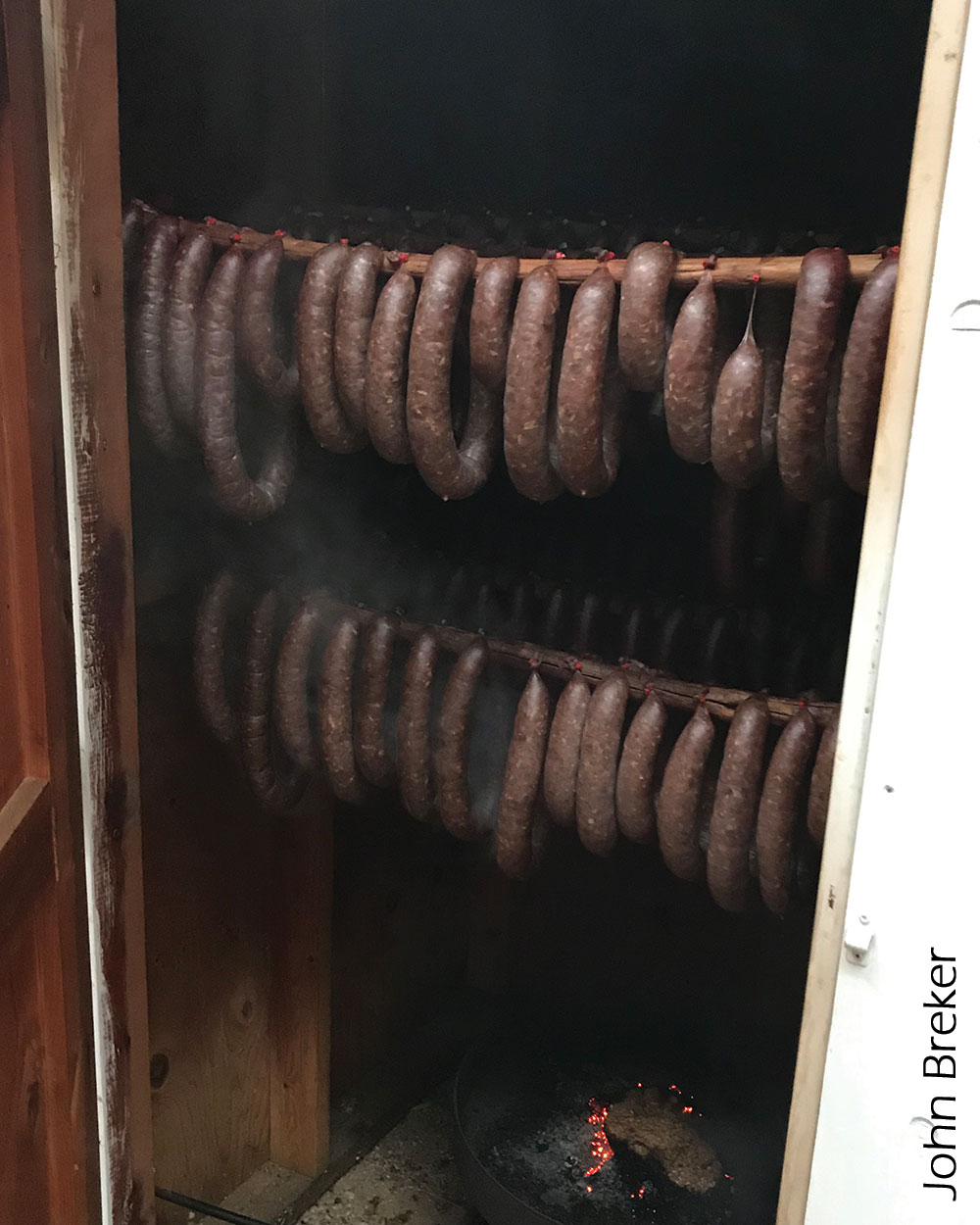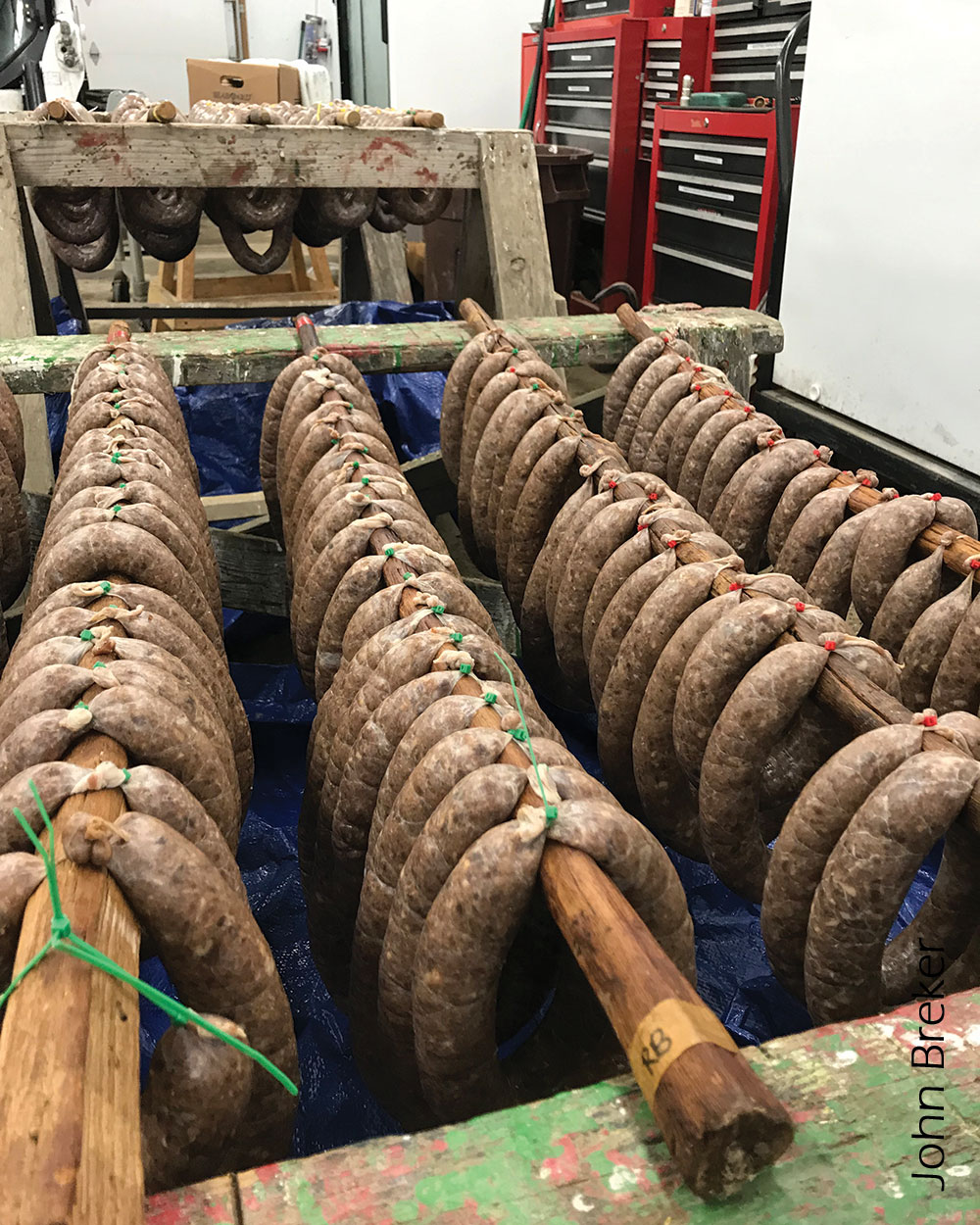
Venison Sausage Connects Generations

Brothers John (left) and Matthew Breker and sister Rachel Olson pause during their venison sausage making operation.
Leah Kastner has been making venison sausage with her parents and sister since she was a kid. Her role in the family assembly line has been the same for almost as long.
“We all have designated jobs, and I am the ‘gut girl,’” she said with a hearty laugh. “I’m usually the one that’s putting the casing on the meat crank. I don’t know how I got stuck with that job!”
Her father, Russ Johnson, hunts white-tailed deer, pronghorn and mule deer across North Dakota, Montana and Wyoming. Once he gets his venison back from the processor, family members gather in the kitchen of the West Fargo home he shares with his wife (and Kastner’s mom), Sandy. Then the sausage making begins in earnest.
Kastner’s sister, Kara Erickson, drives in from Bismarck with her husband, Brad, and son, Cole, in tow. Sometimes cousin Valerie Bensley and her family make the trip from Grand Forks. “Gut girl” is just another cog in a well-oiled machine.
“The guys are usually cranking the meat out and taking it out of the smoker,” Kastner said. “My mom and my sister typically are tying. They’re taking it from me and lining it up on baking sheets to take out to the smoker. And I’m just trying not to let the guts rip, trying not to let the sausage break open.”
There’s a rhythm to the process, a repetitious sense of flow as the family finds its groove, transforming raw venison and pork into ring sausage – and other varieties too.
“We’re a big pancake and waffles family so we kind of get our breakfast sausage for the year,” Kastner said.
Kastner’s son is 6 years old. When the day comes for him to take his place in line, he might discover that he already knows what to do. That’s what happened to John Breker. He’d watched his extended family make sausage in his grandparents’ basement in rural Rutland for as long as he could remember. By the time he and his cousins were old enough to be useful, the third generation of Brekers already knew the basics, seemingly by osmosis.
“It’s just like doing Christmas. Nobody teaches you how to open presents,” he said. “At some point you have a chance to start mixing meat. You might get to put the meat in the grinder. That’s a fascinating process for a little kid.”
It can also be a major production. If the Kastner’s parents had an assembly line in their kitchen, the Breker family operation resembled a small factory.
For one thing, there was a lot more meat to process. Breker estimates that when deer populations were high in the mid-1990s, there could easily be 15 hunters in the family. If just half of them filled their tags, that still meant that there was a lot of venison to process, a small army of aunts, uncles and cousins milling about and plenty of work for many hands.
Eventually, the sausage making operation moved from the basement to the barn at Breker’s mom and dad’s farm. The gleaming, sterile milk room, which had previously served the family’s dairy cows, became sausage central. The family upgraded their supplies to keep up with their volume.
“That milk room was a really great staging area,” Breker said. “We built a big massive table. The boys had an industrial grade meat grinder that was purchased back in the 1970s or 1980s.”

For many families and friends across North Dakota, gathering to make venison sausage from deer harvested during the state’s November season is as much of a tradition as donning blaze orange and pushing deer from tree rows and cattail-ringed sloughs.
They’d leveled up, big time. The equipment had been upgraded, but the process remained consistent. After running the meat through the grinder (Breker recommends a course grind for better texture), cutting the venison with pork from the family farm, and seasoning it in 25-pound batches, the stuffing begins.
The Breker family has made ring baloney as long as anyone can remember, so that’s a main priority. But they make brats as well.
It’s no surprise that hog farmers should prefer pork casings over beef. For Breker, who has since moved off the family farm and into Grand Forks, this is a matter of taste and texture.
“With beef casings, you end up with a much larger sausage and it’s a thicker casing than the pork,” he said. “If you don’t mind eating the casing, I think the pork is just fine. Whereas with the beef, I feel it’s better to peel off. It’s a little bit tough to chew.”
He adds this last part thoughtfully, diplomatically, perhaps thinking of his parents’ neighbors down the road. They raised beef cattle and might have different opinions on the subject.
That’s to be expected. Discussions about sausage seasoning, preparation methods and smoking techniques are part of the venison sausage making experience, even among people working at the same table. The debates and refreshments both help pass the hours. No matter how experienced a group is, sausage making always takes time.
“Dedicate a whole day to smoking sausage,” Breker said. “Don’t think you’re going to get it done the same day as your grinding and stuffing.”
Slow and steady is the way to go for smoking the venison sausages too. The Brekers smoke their brats and ring sausage over apple or hickory, carefully monitoring the temperature as they go. The family constructed a new version of the smoker that Grandpa Melvin made all those years ago.
Rick Diede built his own smoker too. Now the smell of smoked venison sausage serves as a conversation starter in his Fargo neighborhood. It’s also a way to introduce his friends and neighbors (many of whom don’t hunt) to wild game.
“There’s nothing better than walking outside and smelling that smoker,” Diede said. “Even the neighbors smell it. It is kind of a unique thing. Not everybody gets a chance to have that, so I like to share it so that other people can enjoy it.”
The tempting smells wafting through Diede’s neighborhood draw folks like a magnet. He’s experimented with a variety of sausage options throughout the years, including ring sausage, breakfast sausage, brats and pan sausage.
The type of sausages that Diede makes vary. But his preparation is consistent. The process starts the moment he or his grown son, Josh, harvest a deer.
“We are very particular about how our meat is handled once the deer has been harvested,” he said. “We try to get the cape off it right away. I’m a firm believer in getting the hide off the animals right away, and letting it cool down really nice, and make sure that it’s washed down really well. We wash our meat two or three times before we ever freeze it or process it. I want to have clean, fresh meat when we get back.”
Diede said it’s about more than just food quality. It’s a philosophy.

Rick Diede built his own smoker and when it’s fired up, the smell attracts his Fargo neighbors. This is his way of introducing them, especially those who don’t hunt, to wild game.
“It all comes down to respect,“ he said. “You have an obligation out here as a sportsman and a hunter. It’s ethics – take care of what you’ve just taken care of.”
“You’re living off the land, whether it’s growing a crop or harvesting wildlife, so this is just another step in the continuum,” Breker said. “You’re moving the product from the earth to your kitchen table.”
These beliefs are in line with the way that indigenous hunters harvested deer for centuries. Native American nations were organic, ethical, nose to tail eaters before any of these concepts were trendy.
Venison – both tahca sinte ska (white-tailed deer) and tahca sinte sapele (mule deer) – have been a part of Lakota diets for many generations. James Beard award-winning chef, cookbook author and Oglala Lakota educator, Sean Sherman, has sparked new interest in foraging, wild game and traditional food sources native to the Great Plains and Great Lakes.
His cookbook, “The Sioux Chef,” pairs venison with ingredients that most outdoor enthusiasts could spot in the wild, including crushed juniper, sage, wild onions and fresh mushrooms. (And his recipes featuring sumac and cattails just might change the way readers view the landscape during their next hunt, hike or fishing trip.)
Poet, author and editor, Heid E. Erdrich, is a member of the Turtle Mountain Band of Chippewa and grew up in Wahpeton. Her book, “Original Local: Indigenous Food, Stories, And Recipes From The Upper Midwest,” examines the connections between ingredients, history and cultural traditions by sharing recipes and tales from indigenous cooks throughout the region. Her venison recipes are accented with flavors from the north, including wild ginger, leeks and maple sugar, ingredients that can be woven into sausage making and serving suggestions.
Kastner’s family makes pølse (Norwegian for “sausage”) as a nod to Norway. The descendants of Scandinavian immigrants often season their sausages with simple salt and pepper. Or they might add finely chopped onions, or the fragrant mix of allspice, cloves, and coriander found in Danish and Norwegian Christmas sausages.
Potatoes may also make an appearance, especially for those with Swedish ancestry. Swedish potato sausage combines equal amounts of venison, ground pork and potato for a traditional sausage that the sausage makers might not even realize has roots in another nation.
Germany reigns as the sausage king, with an estimated (and mind-boggling) 1,500 varieties of wurst – each with its own special spice blend, list of ingredients and painstaking preparation process. Many of these recipes can be adapted to include venison. Several have found their way to the United States through families like the Brekers. Their sausage is inspired by their ancestors’ roots in Bavaria – with a few Polish influences thrown in for good measure.
But just because recipes are grounded in tradition doesn’t mean they never change. Kastner’s father adds a little mustard seed or extra black pepper from year to year, so the sausage is always evolving. Diede adjusts his sausage recipes too, playing with spices or popping in a little high-temp cheddar or pepper jack cheese to take his brats to the next level. Even those classic Breker family recipes have undergone a few modern transformations.

Like the many different methods to hunt deer in North Dakota – from sitting in tree stands to organized drives – there are that many more venison sausage recipes that families and friends use on their hard-earned wild game.
“In more recent years, it’s gotten a lot more interesting because we’ve been willing to experiment with flavors and recipes that deviated from the traditional family recipes,” Breker said. “We’ve been getting a little bit heavier with sage and thyme or going the spicy route with jalapeños or crushed red pepper.”
Discussing the recipes, making the sausage and taking home the final product are rewarding experiences. But no matter how the sausage making process goes, just gathering is a good time in and of itself.
“It’s kind of a fun family tradition,” Kastner said. “Depending on the time of day, we’ll have a few drinks and crank up the tunes.”
“It’s a blast,” Diede said. “It’s a fun social gathering for a lot of friends. Everybody gets excited. It’s just been more and more people every year. Don’t get me wrong, it’s a lot of work, no doubt about it. But it’s a camaraderie thing.”
The pandemic is limiting the ways that families and friends physically gather together this year. Many hunters and sausage makers didn’t get together in 2020 at all. The prognosis for 2021 is still uncertain. And that’s been hard to take. It’s just another sacrifice in a long and trying year.
But it’s almost impossible to make venison sausage without thinking of the past. Just walking across the plains can remind us of the hunters who walked there before us. Setting up Grandpa’s smoker or our great-uncle’s meat grinder are even more tangible reminders of those who taught us the skills that are now second nature. Our ancestors – no matter where they came from – had hard times too. Acknowledging that connection – and remembering that our own lives are a link in a long generational chain – can help put our strange and unpredictable present into perspective.
No matter what happens this month, this year or in the year to come, the hunt continues. The cycle rolls on. And the sausage making tradition will live on as well, one way or another. It’s just too much fun to let it go. And besides, somebody’s got to get the next generation hooked.
“That’s kind of how it all gets started. Before you even realize, you’re indoctrinated in this cultural and ethnic heritage,” Breker said. “And you take a liking to it. Probably not the work so much when you’re little, but the enjoyment of it. To not only harvest your own deer in the field, but also to turn it into a usable product – it’s part of keeping the tradition alive.”
ALICIA UNDERLEE NELSON is a freelance travel writer and photographer from West Fargo. She blogs frequently about travels within North Dakota on her website, prairiestylefile.com.
